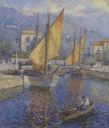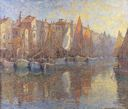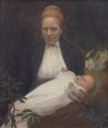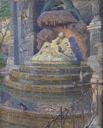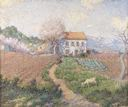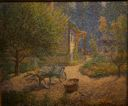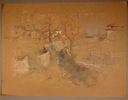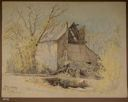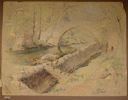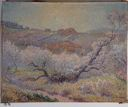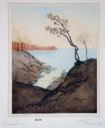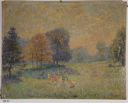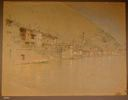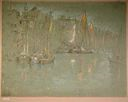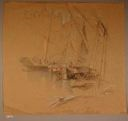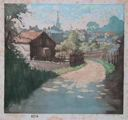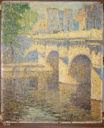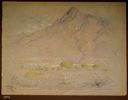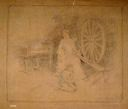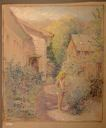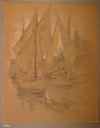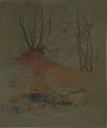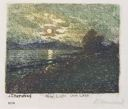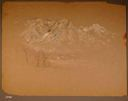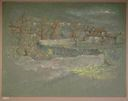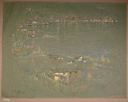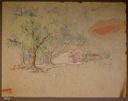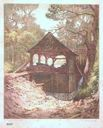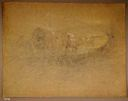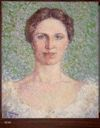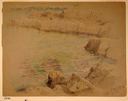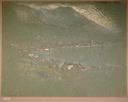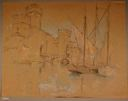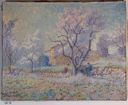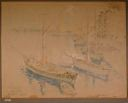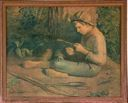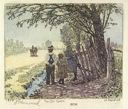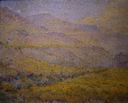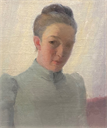James Taylor Harwood
San Francisco School of Design, Académie Julian, Ecole des Beaux Arts painting
(Lehi, Utah, 1860 - 1940, Salt Lake City, Utah)
J. T. Harwood was born in Lehi, Utah, on April 8, 1860, into an arts-oriented family. As a youth he spent time sketching, and later studied art with Utah artists George M. Ottinger and Danquart A. Weggeland. In 1888, at their urging, Harwood became one of the first of a group of Utah-born artists to travel to France and study art in Paris. Before going to Paris, Harwood fell in love with his art student, Harriet Richards; and in 1891, while in Paris, they married. In 1892, he became the first Utahn to have a painting in the prestigious Paris Salon. During the next few years, the Harwoods divided their time between a Salt Lake City studio and Paris, where they returned repeatedly for “refresher” experiences. In 1904, having returned to the United States, James began to teach art in the local Salt Lake City high schools and to paint in his studio. During the period of 1907 to 1910, Harwood’s work changed from tightly controlled Academic Realism paintings similar to the 17th century Dutch and became more oriented toward tonalism and somewhat broader in approach as he moved toward Impressionism. In April of 1921, his beloved Harriet died. Two years later, Harwood became the head of the art department at the University of Utah. As chairman, he developed an art program which craftsmanship, an emphasis that was carried forward long after Harwood was gone. In December of 1927, Harwood met and fell in love with a young literature student, Ione Godwin. Their relationship was considered scandalous because of the age difference of 47 years, but on June 1, 1929, they married. Harwood found in Ione the inspiration to begin a re energized period of work. At 70, Harwood resigned from the University of Utah to have more time to paint and took his family to Paris once again, where he painted, made prints, and participated in exhibits. Over the next nine years, Harwood’s art became recognized for its pointillist style. He made frequent trips to Europe until 1939, when the threat of war kept the Harwoods in Salt Lake City, where he died in October of 1940. Harwood, although an exacting draftsman, had a warm personality and was known as a “patient, loving teacher.” As an artist, he is known for charming “slice of life” genre paintings like Boy and Cat: My Little Son, Heber James and Richard’s Camp, Holiday Park–Weber Canyon as well as for his later pointillist landscapes. He also was a gifted printmaker and watercolorist. The Art In Boy and Cat: My Little Son, Heber James , the artist’s fifth and last child, Heber James Harwood (1905- ), is shown sitting on a pew from an old Latter-day Saint (LDS) chapel, which Harwood bought and put in his studio. The barefooted Heber James wears overalls while he sits and eats a raisin bun. A pet cat curiously sniffs, interested in the food, and the child’s eyes tenderly engage the viewer. The picture is a warm embodiment of family life, painted by a caring father, James T. Harwood. The painting is a combination of the Academic Realist and Impressionist styles. The emphasis on rational space, clarity, order, calm and quiet which Harwood adopted from the academic tradition is combined in this painting with the beginnings of the influences Impressionism would have on him. Through the use of the impressionist brush technique, Harwood was able to capture the essence of the young boy without resorting to minute details.
San Francisco School of Design, Académie Julian, Ecole des Beaux Arts painting
(Lehi, Utah, 1860 - 1940, Salt Lake City, Utah)
J. T. Harwood was born in Lehi, Utah, on April 8, 1860, into an arts-oriented family. As a youth he spent time sketching, and later studied art with Utah artists George M. Ottinger and Danquart A. Weggeland. In 1888, at their urging, Harwood became one of the first of a group of Utah-born artists to travel to France and study art in Paris. Before going to Paris, Harwood fell in love with his art student, Harriet Richards; and in 1891, while in Paris, they married. In 1892, he became the first Utahn to have a painting in the prestigious Paris Salon. During the next few years, the Harwoods divided their time between a Salt Lake City studio and Paris, where they returned repeatedly for “refresher” experiences. In 1904, having returned to the United States, James began to teach art in the local Salt Lake City high schools and to paint in his studio. During the period of 1907 to 1910, Harwood’s work changed from tightly controlled Academic Realism paintings similar to the 17th century Dutch and became more oriented toward tonalism and somewhat broader in approach as he moved toward Impressionism. In April of 1921, his beloved Harriet died. Two years later, Harwood became the head of the art department at the University of Utah. As chairman, he developed an art program which craftsmanship, an emphasis that was carried forward long after Harwood was gone. In December of 1927, Harwood met and fell in love with a young literature student, Ione Godwin. Their relationship was considered scandalous because of the age difference of 47 years, but on June 1, 1929, they married. Harwood found in Ione the inspiration to begin a re energized period of work. At 70, Harwood resigned from the University of Utah to have more time to paint and took his family to Paris once again, where he painted, made prints, and participated in exhibits. Over the next nine years, Harwood’s art became recognized for its pointillist style. He made frequent trips to Europe until 1939, when the threat of war kept the Harwoods in Salt Lake City, where he died in October of 1940. Harwood, although an exacting draftsman, had a warm personality and was known as a “patient, loving teacher.” As an artist, he is known for charming “slice of life” genre paintings like Boy and Cat: My Little Son, Heber James and Richard’s Camp, Holiday Park–Weber Canyon as well as for his later pointillist landscapes. He also was a gifted printmaker and watercolorist. The Art In Boy and Cat: My Little Son, Heber James , the artist’s fifth and last child, Heber James Harwood (1905- ), is shown sitting on a pew from an old Latter-day Saint (LDS) chapel, which Harwood bought and put in his studio. The barefooted Heber James wears overalls while he sits and eats a raisin bun. A pet cat curiously sniffs, interested in the food, and the child’s eyes tenderly engage the viewer. The picture is a warm embodiment of family life, painted by a caring father, James T. Harwood. The painting is a combination of the Academic Realist and Impressionist styles. The emphasis on rational space, clarity, order, calm and quiet which Harwood adopted from the academic tradition is combined in this painting with the beginnings of the influences Impressionism would have on him. Through the use of the impressionist brush technique, Harwood was able to capture the essence of the young boy without resorting to minute details.
Artist Objects
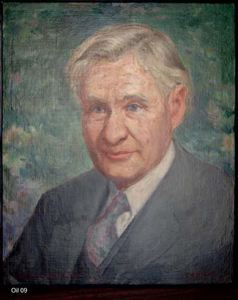
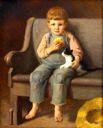






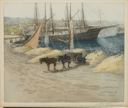



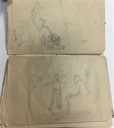
![Image of [Nude Female] First Study for: Adoration of the Ages](/media/Thumbnails/1990.001_1994.999/1992.066.png)








